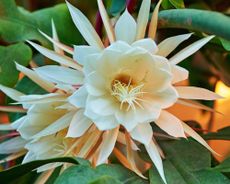Striped Toga Eggplant History

I have to admit I hate eggplant. Although it has value in a number of cuisines, the fruits can be too mushy and sweet for my palate. However, a cute little member of the family, Striped Toga eggplant, is both edible and an ornamental plant. A native of Africa, this eggplant is charming in its appearance and produces lovely little bushes decorated with small golden orange-yellow striped fruits. Growing Striped Toga plants requires a United States Department of Agriculture zone of 10 or higher, or early indoor starting and transplant to successfully produce fruits.
Striped Toga Eggplant History
Solanum aethiopicum is the scientific designation for Striped Toga, although Seed Savers has it listed as Solanum melongena. The spelling, too, may be found as Striped Togo with an "o" rather than an "a" depending on who you talk to. A little Striped Toga eggplant history can help identify its growing needs, however. This small fruit hails from sub-Saharan Africa and is known there as scarlet or African eggplant. In warmer regions, the plant is a perennial, but for northern gardeners, it will be an annual specimen. Older plants will be semi-woody but annuals are herbaceous. The plant produces a compact, low-growing shrub of between 3 and 6 feet in height with a similar spread. Just like tomatoes, eggplants can be determinate or indeterminate in bloom time. Striped Toga is indeterminate, which means they will bloom and set fruit throughout the season. But, unlike indeterminate tomatoes, this eggplant doesn't usually require staking. Heirloom eggplants and other vegetables are all the rage. Finding that unique seed which has stood the test of time is an unapologetic habit for many gardeners. Striped Toga is a pure strain of the African variety, and the fruits are said to be sweet and tasty, although some say there is a lingering bitterness. Whether you love to eat eggplant or simply want to grow something new, Striped Toga will delight your eyes even if you don't use the fruit. The fruits are 1 to 3 inches long, oblong and start out yellow, transitioning to green and finally glorious ripe golden orange with distinctive green stripes. The leaves are large, lobed and bluish green. Some parts of the plant may develop thorns. The lavender 5-petaled flowers add to the plant's seasonal appeal.
Growing Striped Toga Plants
Striped toga should be started indoors 8 weeks before the date of the last frost. It can take 75 to 85 days after transplant for usable fruits, so take that into consideration when planning to add this eggplant to your garden. Plant seeds ¼ to ½ inch deep and 18 to 24 inches apart. Striped Toga is a heavy feeder. The planting bed should have plenty of organic matter incorporated to fulfill the plant's needs. It also needs consistent moisture to produce the biggest fruits; however, avoid overhead watering which can lead to fungal diseases on leaves. With some careful planning, even temperate region gardeners can be enjoying the succulent flesh and cartoonish appeal of these sweet little eggplants by the end of summer.
Gardening tips, videos, info and more delivered right to your inbox!
Sign up for the Gardening Know How newsletter today and receive a free download of our most popular eBook "How to Grow Delicious Tomatoes."
-
 7 Best Dwarf Tomato Plants
7 Best Dwarf Tomato PlantsHave a tiny growing space? Look for dwarf tomato seeds so you don’t miss out on summer’s juicy bounty.
By Susan Albert
-
 5 Night-Blooming Houseplants – Grow An Indoor Moon Garden
5 Night-Blooming Houseplants – Grow An Indoor Moon GardenThere is something uniquely special about night-blooming houseplants. Set the scene for a magical evening indoors with these fragrant flowering beauties.
By Amy Grant